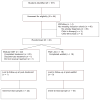Effectiveness of modular CBT for child anxiety in elementary schools
- PMID: 23750860
- PMCID: PMC4231200
- DOI: 10.1037/spq0000017
Effectiveness of modular CBT for child anxiety in elementary schools
Abstract
Most randomized controlled trials of cognitive-behavioral therapy (CBT) for children with anxiety disorders have evaluated treatment efficacy using recruited samples treated in research settings. Clinical trials in school settings are needed to determine if CBT can be effective when delivered in real world settings. This study evaluated a modular CBT program for childhood anxiety disorders in two elementary schools. Forty children (5-12 years old) with anxiety disorders, referred by teachers and school staff, were randomly assigned to modular CBT or a 3-month waitlist. Clinicians worked with individual families as well as teachers and school staff. Evaluators blind to treatment condition conducted structured diagnostic interviews and caregivers and children completed symptom checklists at pre- and posttreatment. The primary study outcome, the Clinical Global Impressions-Improvement scale, yielded a positive treatment response at posttreatment for 95.0% of CBT participants, as compared with only 16.7% of the waitlist participants. CBT also outperformed the waitlist on diagnostic outcomes and caregiver-report measures of anxiety. Treatment effects did not extend beyond anxiety diagnoses and symptoms. Results suggest that modular CBT delivered within the elementary school setting may be effective for the treatment of child anxiety disorders. A replication of the study results with a larger sample is indicated.
References
-
- Achenbach TM. Manual for the child behavior checklist and 1991 profile. Burlington, VT: University of Vermont; 1991.
-
- Achenbach TM, Bird HR, Canino G, Phares V, Gould MS, Rubio-Stipec M. Epidemiological comparisons of Puerto Rican and U.S. mainland children: Parent, teacher, and self-reports. Journal of the American Academy of Child and Adolescent Psychiatry. 1990;29:84–93. doi: 10.1097/00004583-199001000-00014. - DOI - PubMed
-
- Atkins MS, Graczyk PA, Frazier SL, Abdul-Adil J. Toward a new model for promoting urban children’s mental health: Accessible, effective, and sustainable school-based mental health services. School Psychology Review. 2003;32:503–514.
Publication types
MeSH terms
Grants and funding
LinkOut - more resources
Full Text Sources
Other Literature Sources
Medical


